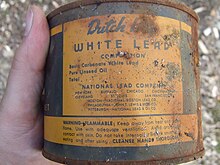
Back Pintura de plom Catalan Pintura a base de plomo Spanish رنگ سرب Persian Peinture au plomb French Cat timbal ID Tinta à base de chumbo Portuguese Свинцева фарба Ukrainian


Lead paint or lead-based paint is paint containing lead. As pigment, lead(II) chromate (PbCrO
4, "chrome yellow"), lead(II,IV) oxide, (Pb
3O
4, "red lead"), and lead(II) carbonate (PbCO
3, "white lead") are the most common forms.[1] Lead is added to paint to accelerate drying, increase durability, maintain a fresh appearance, and resist moisture that causes corrosion. It is one of the main health and environmental hazards associated with paint. Lead paint has been generally phased out of use due to the toxic nature of lead. Alternatives such as water-based, lead-free traffic paint are readily available.
In some countries, lead continues to be added to paint intended for domestic use,[2] whereas countries such as the United States and the United Kingdom have regulations prohibiting its use. However, lead paint may still be found in older properties painted prior to the introduction of such regulations. Although lead has been banned from household paints in the United States since 1978, it may still be found in road marking paint.[3]
- ^ Völz, Hans G.; et al. (2006). "Pigments, Inorganic". Ullmann's Encyclopedia of Industrial Chemistry. Weinheim: Wiley-VCH. doi:10.1002/14356007.a20_243.pub2. ISBN 3527306730..
- ^ "Lead-laden paint still widely sold around the world". Reuters. 25 August 2009. Archived from the original on 25 January 2021. Retrieved 1 July 2017.
- ^ "Lead Chromate: Why it is Banned in Most Industries Apart From Road Markings". Road Traffic Technology. Verdict Media Limited. Retrieved 28 June 2022.
© MMXXIII Rich X Search. We shall prevail. All rights reserved. Rich X Search